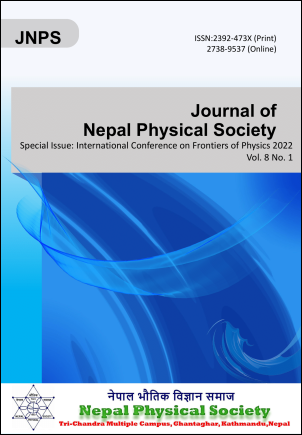SRIM as a Computational Tool to Study Energy Required During Prostate Cancer Treatment
DOI:
https://doi.org/10.3126/jnphyssoc.v8i1.48285Keywords:
Proton beam therapy, Radiation therapy, Prostate cancer, Stopping powerAbstract
Proton beam therapy is a promising technique to cure various types of cancer diseases in the human body. Employing this technique, the prostate cancer cells are damaged primarily leaving the surrounding cells unaffected. Initially, the position of the prostate cancer is determined then the energy required to damage cancerous cells is calculated computationally. The energy loss to the damaged cells and other layers of the human body via which the proton beam travels is calculated separately with high accuracy. It is found that 65 MeV energy of proton beam when interacts with various layers, particularly with cancerous cells, the maximum energy is imparted to these cancerous cells to destroy them effectively. TRIM data shows that 99.96% of the energy of proton is lost in the process of ionization by ion and 0.02% in ionization by recoils and only 0.01% energy is lost by production of phonon by ion and 0.02% by recoils. 65 MeV of the energy deposited on various layers viz. skin, connective tissue, soft muscles and prostate are approximately 0.384 MeV (i.e. 0.595%), 6.585 MeV (i.e. 10.20%), 14.654 MeV (22.71%), and 42.896 MeV (66.49%) respectively with the calculation error 0.74%. Ion range and lateral distribution calculation enable us to visualize the overall picture of the process of the simulation. SRIM data illustrates that more than 99% of the energy of the proton is lost during the ionization process while phonon production is almost negligible. The energy of proton beam deposited on various layers viz. skin, connective tissue, soft muscles and prostate cancerous cells among them the prostate cells receive the maximum energy. This technique not only cures prostate cancer effectively but also ensures that it has no side effects and the surrounding tissues or cells remain unaffected.
Downloads
Downloads
Published
How to Cite
Issue
Section
License
All right reserved. No part of this Journal may be reproduced in any form or by any electronic or mechanical means, including information storage and retrieval system, without permission in writing from the publisher, except by a reviewer who may quote brief passage in a review. The views and interpretation in this journal are those of author(s) and they are not attributable to the NPS.




